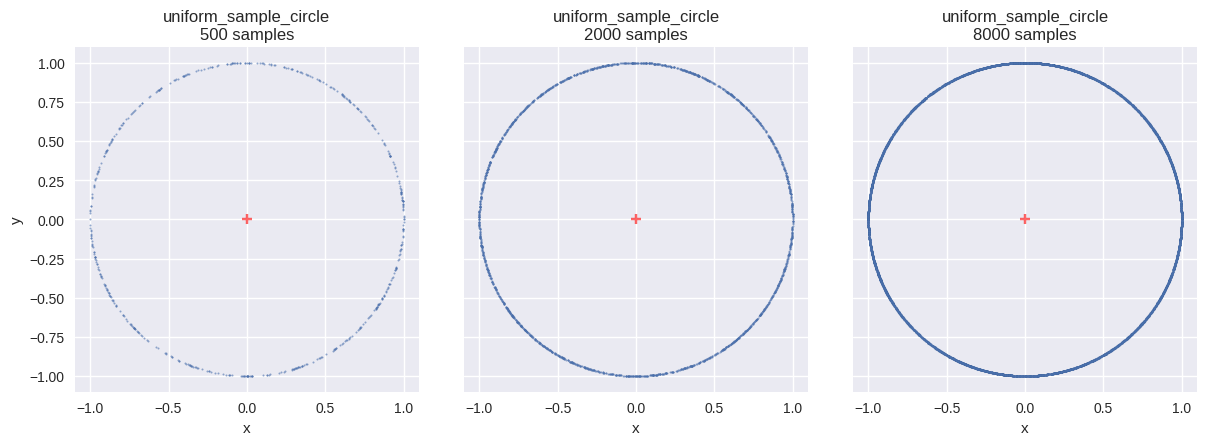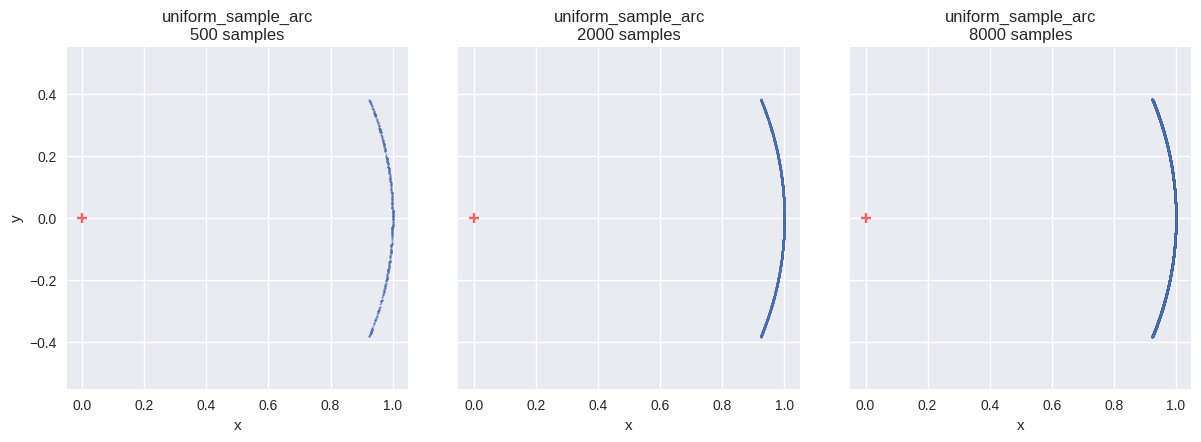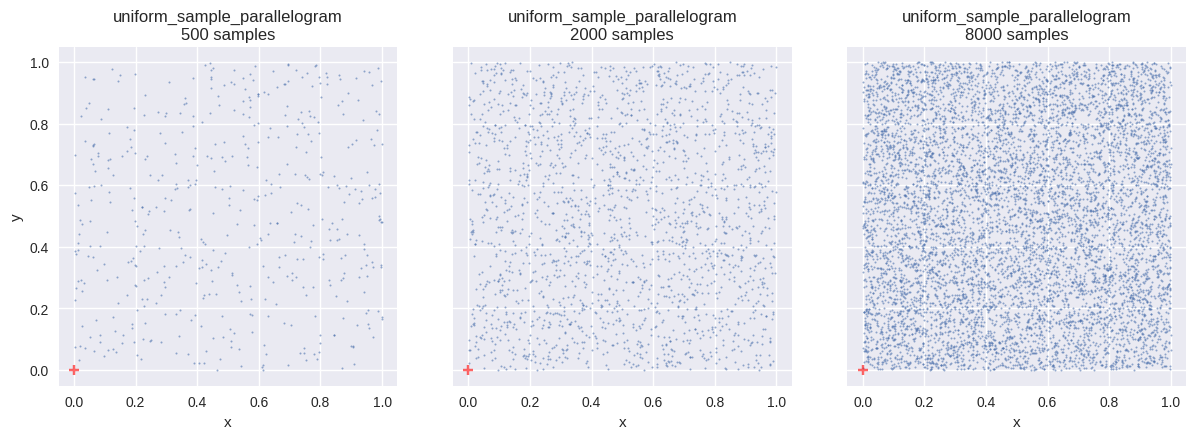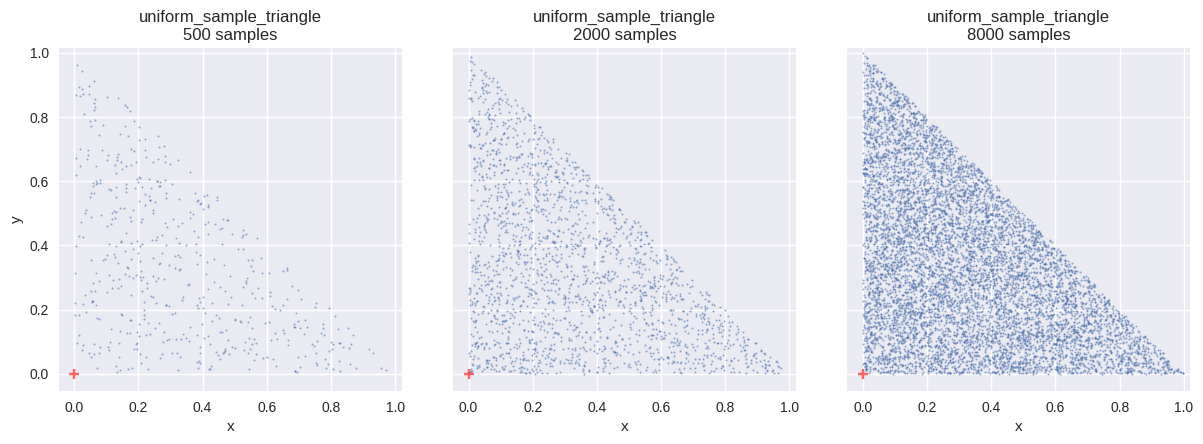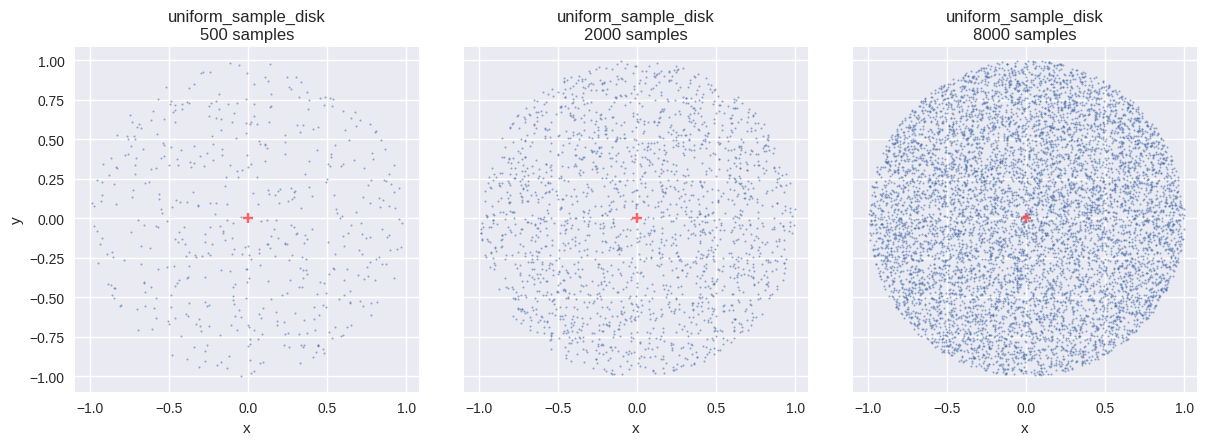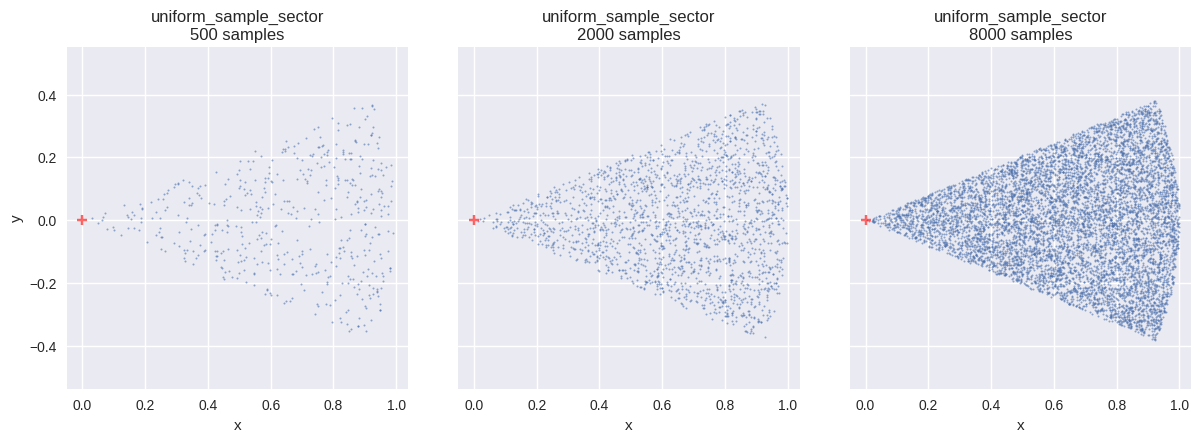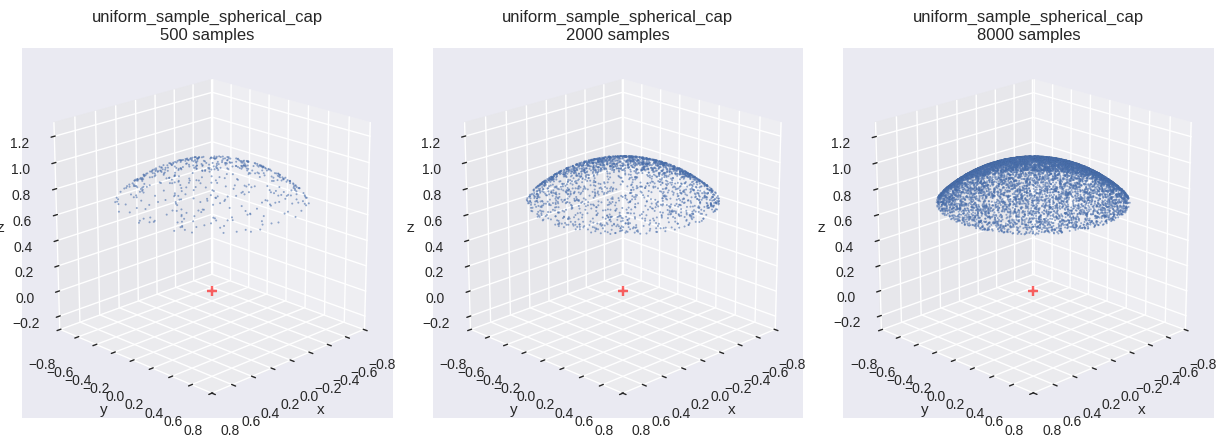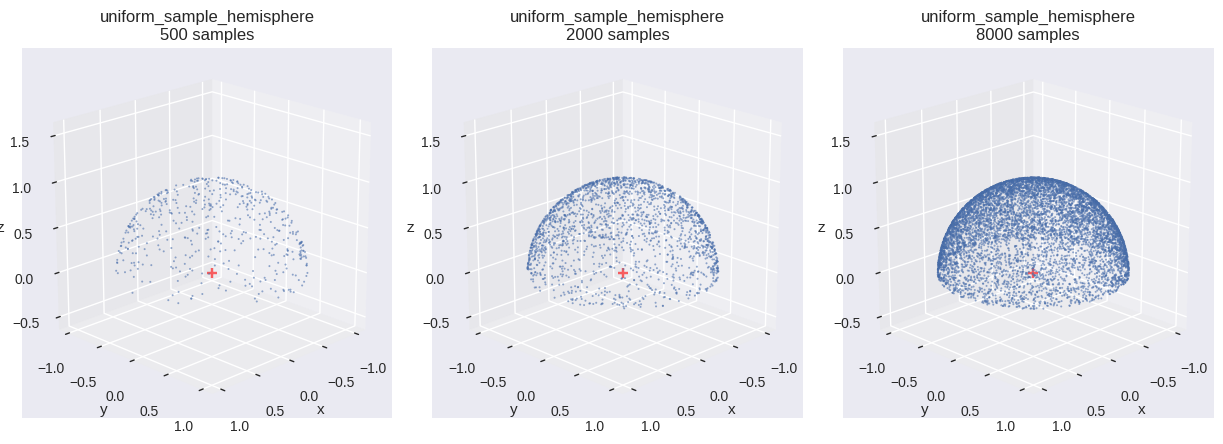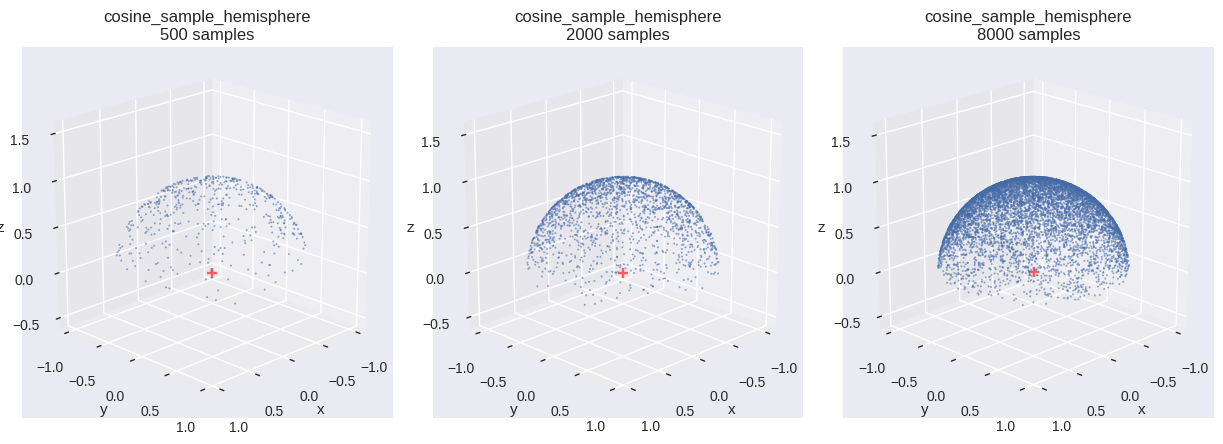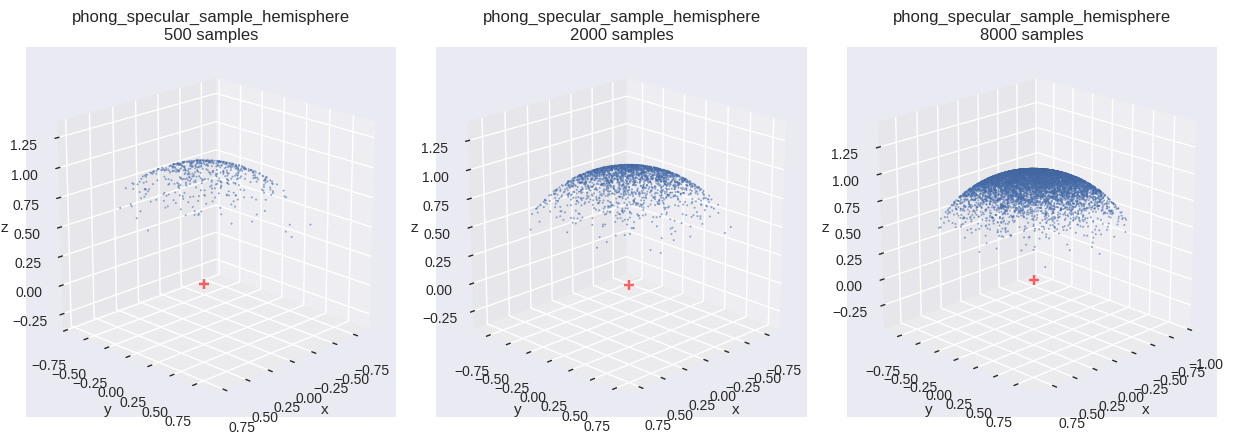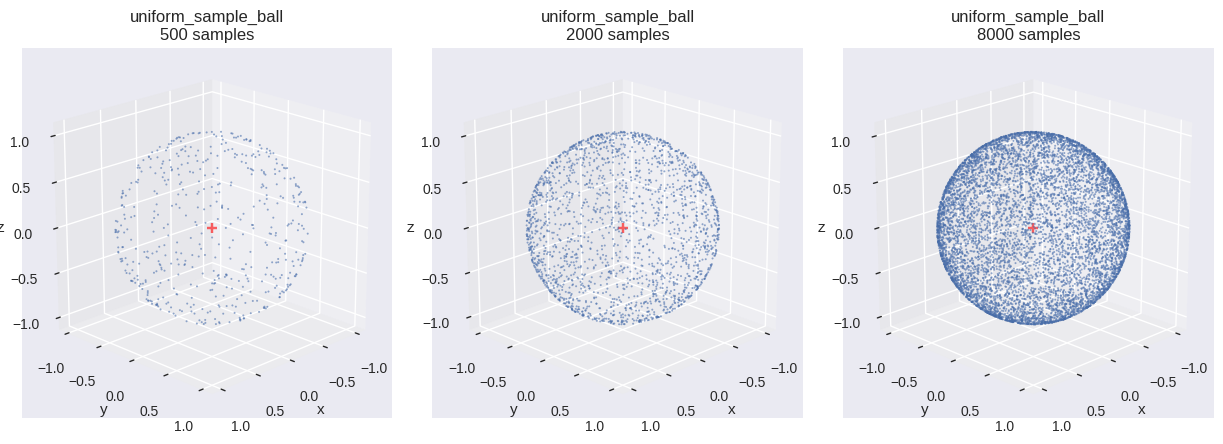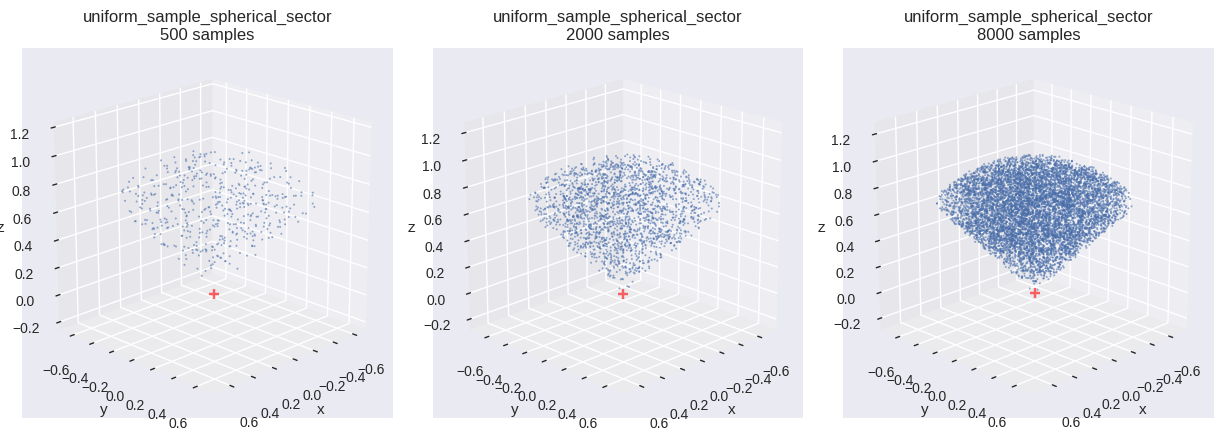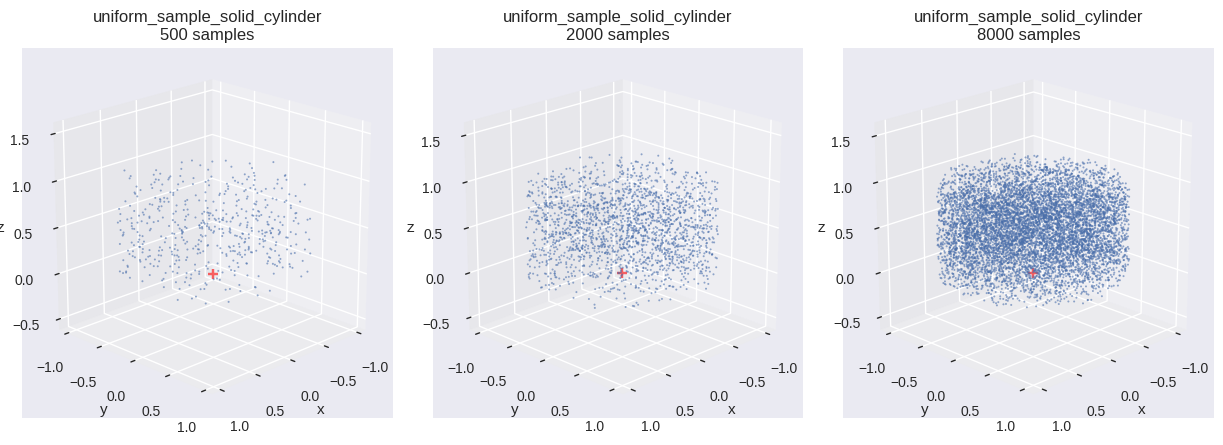2次元サンプリング
平行四辺形(parallelogram)内の一様分布
確率変数 \(\boldsymbol{X}\) が、平面上の領域 \(S\) 内に一様分布するとする.
\[
S: \boldsymbol{x}(u,v)=\boldsymbol{x}_{1}+u(\boldsymbol{x}_{2}-\boldsymbol{x}_{1})+v(\boldsymbol{x}_{4}-\boldsymbol{x}_{1})
,\quad
0\le u,v\le 1
\]
\(\boldsymbol{x}_{i}\) は平行四辺形の頂点であり,辺の対応は,
\[
\boldsymbol{x}_{3}
=\boldsymbol{x}_{2}+\boldsymbol{x}_{4}-\boldsymbol{x}_{1}
\]
で定まるものとする.同時確率密度関数は領域 \(S\) で定数 \(c\) であり,正規化条件を考える.面積要素は,
\[
dS
=\left\|\frac{\partial\boldsymbol{x}}{\partial u}\times\frac{\partial\boldsymbol{x}}{\partial v}\right\|\,dudv
=A\,dudv
\]
ここで,平行四辺形の面積を \(A=\left\|\frac{\partial\boldsymbol{x}}{\partial u}\times\frac{\partial\boldsymbol{x}}{\partial v}\right\|\) とした.したがって,
\[
1
=\iint_{S} c\,dS
=\int_{0}^{1}\int_{0}^{1} cA\,dudv
=c\cdot A
\]
同時確率密度関数は,
\[
p_{\boldsymbol{X}}(\boldsymbol{x})
=\frac{1}{A}
,\quad
p_{U,V}(u,v)
=p_{\boldsymbol{X}}(\boldsymbol{x})\frac{dS}{dudv}
=1
\]
周辺確率密度関数は,
\[
p_{U}(u)
=\int_{0}^{1} p_{U,V}(u,v)\,dv
=1
,\quad
p_{V}(v)
=\int_{0}^{1} p_{U,V}(u,v)\,du
=1
\]
累積分布関数は,
\[
P_{U}(u)
=\int_{0}^{u} p_{U}(t)\,dt
=u
,\quad
P_{V}(v)
=\int_{0}^{v} p_{V}(t)\,dt
=v
\]
逆関数は,
\[
P^{-1}_{U}(\zeta_{1})
=\zeta_{1}
,\quad
P^{-1}_{V}(\zeta_{2})
=\zeta_{2}
\]
コード
def uniform_sample_parallelogram(u0, u1):return np.stack((u0, u1), axis=- 1 )= uniform_sample_parallelogram # type: ignore = f" { fn. __name__ } \n{{}} samples" = [{"fn" : fn, "num_samples" : n, "title" : title.format (n)} for n in SAMPLE_SIZES]= (int (math.ceil(len (distr_infos) / 3 )), 3 ))
三角形(triangle)内の一様分布
確率変数 \(\boldsymbol{X}\) が、平面上の領域 \(S\) 内に一様分布するとする.
\[
S: \boldsymbol{x}(\lambda_{1},\lambda_{2})=\lambda_{1}\boldsymbol{x}_{1}+\lambda_{2}\boldsymbol{x}_{2}+(1-\lambda_{1}-\lambda_{2})\boldsymbol{x}_{3}
,\quad
\lambda_{i}\ge 0,\,\lambda_{1}+\lambda_{2}\le 1
\]
同時確率密度関数は領域 \(S\) で定数 \(c\) であり,正規化条件を考える.面積要素は,
\[
dS
=\left\|\frac{\partial\boldsymbol{x}}{\partial \lambda_{1}}\times\frac{\partial\boldsymbol{x}}{\partial \lambda_{2}}\right\|\,d\lambda_{1}d\lambda_{2}
=2A\,d\lambda_{1}d\lambda_{2}
\]
ここで,三角形の面積を \(A=\frac{1}{2}\left\|\frac{\partial\boldsymbol{x}}{\partial\lambda_{1}}\times\frac{\partial\boldsymbol{x}}{\partial\lambda_{2}}\right\|\) とした.したがって,
\[
1
=\iint_{S} c\,dS
=\int_{0}^{1}\int_{0}^{1-\lambda_{2}} c2A\,d\lambda_{1}d\lambda_{2}
=c\cdot A
\]
同時確率密度関数は,
\[
p_{\boldsymbol{X}}(\boldsymbol{x})
=\frac{1}{A}
,\quad
p_{\Lambda_{1},\Lambda_{2}}(\lambda_{1},\lambda_{2})
=p_{\boldsymbol{X}}(\boldsymbol{x})\frac{dS}{d\lambda_{1}d\lambda_{2}}
=2
\]
周辺確率密度関数は,
\[
p_{\Lambda_{1}}(\lambda_{1})
=\int_{0}^{1-\lambda_{1}} p_{\Lambda_{1},\Lambda_{2}}(\lambda_{1},\lambda_{2})\,d\lambda_{2}
=2(1-\lambda_{1})
,\quad
p_{\Lambda_{2}}(\lambda_{2})
=\int_{0}^{1-\lambda_{2}} p_{\Lambda_{1},\Lambda_{2}}(\lambda_{1},\lambda_{2})\,d\lambda_{1}
=2(1-\lambda_{2})
\]
\(\Lambda_{1}, \Lambda_{2}\) は独立ではないので,
\[
p_{\Lambda_{2}|\Lambda_{1}}(\lambda_{2}|\lambda_{1})
=\frac{p_{\Lambda_{1},\Lambda_{2}}(\lambda_{1},\lambda_{2})}{p_{\Lambda_{1}}(\lambda_{1})}
=\frac{1}{1-\lambda_{1}}
\]
累積分布関数は,
\[
P_{\Lambda_{1}}(\lambda_{1})
=\int_{0}^{\lambda_{1}} p_{\Lambda_{1}}(t)\,dt
=2\lambda_{1}-\lambda^{2}_{1}
,\quad
P_{\Lambda_{2}|\Lambda_{1}}(\lambda_{2}|\lambda_{1})
=\int_{0}^{\lambda_{2}} p_{\Lambda_{2}|\Lambda_{1}}(t|\lambda_{1})\,dt
=\frac{\lambda_{2}}{1-\lambda_{1}}
\]
逆関数は,
\[
P^{-1}_{\Lambda_{1}}(\zeta_{1})
=1-\sqrt{1-\zeta_{1}}
,\quad
P^{-1}_{\Lambda_{2}|\Lambda_{1}}(\zeta_{2}|\lambda_{1})
=(1-\lambda_{1})\zeta_{2}
\]
コード
def uniform_sample_triangle(u0, u1):= 1.0 - np.sqrt(u0) # np.sqrt(1.0 - u0) = (1.0 - lambda0) * u1= (lambda0, lambda1)return np.stack(x, axis=- 1 )= uniform_sample_triangle # type: ignore = f" { fn. __name__ } \n{{}} samples" = [{"fn" : fn, "num_samples" : n, "title" : title.format (n)} for n in SAMPLE_SIZES]= (int (math.ceil(len (distr_infos) / 3 )), 3 ))
円板(disk)内の一様分布
確率変数 \(\boldsymbol{X}\) が、平面上の領域 \(S\) 内に一様分布するとする.
\[
S: \boldsymbol{x}(\rho,\phi)=\rho(\cos\phi\,\boldsymbol{b}_1+\sin\phi\,\boldsymbol{b}_2)
,\quad
0\le\rho\le R,\, 0\le\phi\lt 2\pi
\]
同時確率密度関数は領域 \(S\) で定数 \(c\) であり,正規化条件を考える.面積要素は,
\[
dS
=\left\|\frac{\partial\boldsymbol{x}}{\partial\rho}\times\frac{\partial\boldsymbol{x}}{\partial\phi}\right\|\,d\rho d\phi
=\rho\,d\rho d\phi
\]
したがって,
\[
1
=\iint_{S} c\,dS
=\int_{0}^{2\pi}\int_{0}^{R} c\rho\,d\rho d\phi
=c\cdot \pi R^{2}
\]
同時確率密度関数は,
\[
p_{\boldsymbol{X}}(\boldsymbol{x})
=\frac{1}{\pi R^{2}}
,\quad
p_{\mathrm{P},\Phi}(\rho,\phi)
=p_{\boldsymbol{X}}(\boldsymbol{x})\frac{dS}{d\rho d\phi}
=\frac{\rho}{\pi R^{2}}
\]
周辺確率密度関数は,
\[
p_{\mathrm{P}}(\rho)
=\int_{0}^{2\pi} p_{\mathrm{P},\Phi}(\rho,\phi)\,d\phi
=\frac{2\rho}{R^{2}}
,\quad
p_{\Phi}(\phi)
=\int_{0}^{R} p_{\mathrm{P},\Phi}(\rho,\phi)\,d\rho
=\frac{1}{2\pi}
\]
累積分布関数は,
\[
P_{\mathrm{P}}(\rho)
=\int_{0}^{\rho} p_{\mathrm{P}}(t)\,dt
=\frac{\rho^{2}}{R^{2}}
,\quad
P_{\Phi}(\phi)
=\int_{0}^{\phi} p_{\Phi}(t)\,dt
=\frac{\phi}{2\pi}
\]
逆関数は,
\[
P^{-1}_{\mathrm{P}}(\zeta_{1})
=R\sqrt{\zeta_{1}}
,\quad
P^{-1}_{\Phi}(\zeta_{2})
=2\pi\zeta_{2}
\]
コード
def uniform_sample_disk(u0, u1):= np.sqrt(u0)= 2.0 * np.pi * u1= (np.cos(phi), np.sin(phi))return rho[:, np.newaxis] * np.stack(x, axis=- 1 )= uniform_sample_disk # type: ignore = f" { fn. __name__ } \n{{}} samples" = [{"fn" : fn, "num_samples" : n, "title" : title.format (n)} for n in SAMPLE_SIZES]= (int (math.ceil(len (distr_infos) / 3 )), 3 ))
扇形(sector)内の一様分布
確率変数 \(\boldsymbol{X}\) が、平面上の領域 \(S\) 内に一様分布するとする.
\[
S: \boldsymbol{x}(\rho,\phi)=\rho(\cos\phi\,\boldsymbol{b}_1+\sin\phi\,\boldsymbol{b}_2)
,\quad
0\le\rho\le R,\, -\frac{\phi_{\text{max}}}{2}\le\phi\le\frac{\phi_{\text{max}}}{2}
\]
同時確率密度関数は領域 \(S\) で定数 \(c\) であり,正規化条件を考える.面積要素は,
\[
dS
=\left\|\frac{\partial\boldsymbol{x}}{\partial\rho}\times\frac{\partial\boldsymbol{x}}{\partial\phi}\right\|\,d\rho d\phi
=\rho\,d\rho d\phi
\]
したがって,
\[
1
=\iint_{S} c\,dS
=\int_{-\frac{\phi_{\text{max}}}{2}}^{\frac{\phi_{\text{max}}}{2}}\int_{0}^{R} c\rho\,d\rho d\phi
=c\cdot \frac{R^{2}\phi_{\text{max}}}{2}
\]
同時確率密度関数は,
\[
p_{\boldsymbol{X}}(\boldsymbol{x})
=\frac{2}{R^{2}\phi_{\text{max}}}
,\quad
p_{\mathrm{P},\phi}(\rho,\phi)
=p_{\boldsymbol{X}}(\boldsymbol{x})\frac{dS}{d\rho d\phi}
=\frac{2\rho}{R^{2}\phi_{\text{max}}}
\]
周辺確率密度関数は,
\[
p_{\mathrm{P}}(\rho)
=\int_{-\frac{\phi_{\text{max}}}{2}}^{\frac{\phi_{\text{max}}}{2}} p_{\mathrm{P},\phi}(\rho,\phi)\,d\phi
=\frac{2\rho}{R^{2}}
,\quad
p_{\Phi}(\phi)
=\int_{0}^{R} p_{\mathrm{P},\phi}(\rho,\phi)\,d\rho
=\frac{1}{\phi_{\text{max}}}
\]
累積分布関数は,
\[
P_{\mathrm{P}}(\rho)
=\int_{0}^{\rho} p_{\mathrm{P}}(t)\,dt
=\frac{\rho^{2}}{R^{2}}
,\quad
P_{\Phi}(\phi)
=\int_{-\frac{\phi_{\text{max}}}{2}}^{\phi} p_{\Phi}(t)\,dt
=\frac{\phi+\frac{\phi_{\text{max}}}{2}}{\phi_{\text{max}}}
\]
逆関数は,
\[
P^{-1}_{\mathrm{P}}(\zeta_{1})
=R\sqrt{\zeta_{1}}
,\quad
P^{-1}_{\Phi}(\zeta_{2})
=\phi_{\text{max}}\left(\zeta_{2}-\frac{1}{2}\right)
\]
コード
def uniform_sample_sector(u0, u1, * , phi_max= np.pi):= np.sqrt(u0)= phi_max * (u1 - 0.5 )= (np.cos(phi), np.sin(phi))return rho[:, np.newaxis] * np.stack(x, axis=- 1 )= uniform_sample_sector # type: ignore = {"phi_max" : 0.25 * np.pi}= f" { fn. __name__ } \n{{}} samples" = [{"fn" : fn, "num_samples" : n, "fn_kwargs" : fn_kwargs, "title" : title.format (n)} for n in SAMPLE_SIZES]= (int (math.ceil(len (distr_infos) / 3 )), 3 ))
球(sphere)上の一様分布
確率変数 \(\boldsymbol{X}\) が,曲面 \(S\) 上に一様分布するとする.
\[
S: \boldsymbol{x}(\theta,\phi)=
\begin{pmatrix}
R\sin\theta\cos\phi\\
R\sin\theta\sin\phi\\
R\cos\theta
\end{pmatrix}
,\quad
0\le\theta\le\pi,\,0\le\phi\lt 2\pi
\]
同時確率密度関数は曲面 \(S\) で定数 \(c\) であり,正規化条件を考える.面積要素は,
\[
dS
=\left\|\frac{\partial\boldsymbol{x}}{\partial\theta}\times\frac{\partial\boldsymbol{x}}{\partial\phi}\right\|\,d\theta d\phi
=R^{2}\sin\theta\,d\theta d\phi
\]
したがって,
\[
1
=\int_{S} c\,dS
=\int_{0}^{2\pi}\int_{0}^{\pi} cR^{2}\sin\theta\,d\theta d\phi
=c\cdot 4\pi R^{2}
\]
同時確率密度関数は,
\[
p_{\boldsymbol{X}}(\boldsymbol{x})
=\frac{1}{4\pi R^{2}}
,\quad
p_{\Theta,\Phi}(\theta,\phi)
=p_{\boldsymbol{X}}(\boldsymbol{x})\frac{dS}{d\theta d\phi}
=\frac{\sin\theta}{4\pi}
\]
周辺確率密度関数は,
\[
p_{\Theta}(\theta)
=\int_{0}^{2\pi} p_{\Theta,\Phi}(\theta,\phi)\,d\phi
=\frac{\sin\theta}{2}
,\quad
p_{\Phi}(\phi)
=\int_{0}^{\pi} p_{\Theta,\Phi}(\theta,\phi)\,d\theta
=\frac{1}{2\pi}
\]
累積分布関数は,
\[
P_{\Theta}(\theta)
=\int_{0}^{\theta} p_{\Theta}(t)\,dt
=\frac{1-\cos\theta}{2}
,\quad
P_{\Phi}(\phi)
=\int_{0}^{\phi} p_{\Phi}(t)\,dt
=\frac{\phi}{2\pi}
\]
逆関数は,
\[
P^{-1}_{\Theta}(\zeta_{1})
=\arccos(1-2\zeta_{1})
,\quad
P^{-1}_{\Phi}(\zeta_{2})
=2\pi\zeta_{2}
\]
コード
def uniform_sample_sphere(u0, u1):= 1.0 - 2.0 * u0= np.sqrt(1.0 - c * c)= 2.0 * np.pi * u1= (s * np.cos(phi), s * np.sin(phi), c)return np.stack(w, axis=- 1 )= uniform_sample_sphere # type: ignore = f" { fn. __name__ } \n{{}} samples" = [{"fn" : fn, "num_samples" : n, "title" : title.format (n)} for n in SAMPLE_SIZES]= (int (math.ceil(len (distr_infos) / 3 )), 3 ))
球冠(spherical cap)上の一様分布
確率変数 \(\boldsymbol{X}\) が,曲面 \(S\) 上で一様分布するとする.
\[
S: \boldsymbol{x}(\theta,\phi)=
\begin{pmatrix}
R\sin\theta\cos\phi\\
R\sin\theta\sin\phi\\
R\cos\theta
\end{pmatrix}
,\quad
0\le\theta\le\theta_{\text{max}},\,0\le\phi\lt 2\pi
\]
同時確率密度関数は曲面 \(S\) で定数 \(c\) であり,正規化条件を考える.面積要素は,
\[
dS
=\left\|\frac{\partial\boldsymbol{x}}{\partial\theta}\times\frac{\partial\boldsymbol{x}}{\partial\phi}\right\|\,d\theta d\phi
=R^{2}\sin\theta\,d\theta d\phi
\]
したがって,
\[
1
=\int_{S} c\,dS
=\int_{0}^{2\pi}\int_{0}^{\theta_{\text{max}}} cR^{2}\sin\theta\,d\theta d\phi
=c\cdot 2\pi R^{2}(1-\cos\theta_{\text{max}})
\]
同時確率密度関数は,
\[
p_{\boldsymbol{X}}(\boldsymbol{x})
=\frac{1}{2\pi R^{2}(1-\cos\theta_{\text{max}})}
,\quad
p_{\Theta,\Phi}(\theta,\phi)
=p_{\boldsymbol{X}}(\boldsymbol{x})\frac{dS}{d\theta d\phi}
=\frac{\sin\theta}{2\pi(1-\cos\theta_{\text{max}})}
\]
周辺確率密度関数は,
\[
p_{\Theta}(\theta)
=\int_{0}^{2\pi} p_{\Theta,\Phi}(\theta,\phi)\,d\phi
=\frac{\sin\theta}{1-\cos\theta_{\text{max}}}
,\quad
p_{\Phi}(\phi)
=\int_{0}^{\theta_{\text{max}}} p_{\Theta,\Phi}(\theta,\phi)\,d\theta
=\frac{1}{2\pi}
\]
累積分布関数は,
\[
P_{\Theta}(\theta)
=\int_{0}^{\theta} p_{\Theta}(t)\,dt
=\frac{1-\cos\theta}{1-\cos\theta_{\text{max}}}
,\quad
P_{\Phi}(\phi)
=\int_{0}^{\phi} p_{\Phi}(t)\,dt
=\frac{\phi}{2\pi}
\]
逆関数は,
\[
P^{-1}_{\Theta}(\zeta_{1})
=\arccos(1-(1-\cos\theta_{\text{max}})\zeta_{1})
,\quad
P^{-1}_{\Phi}(\zeta_{2})
=2\pi\zeta_{2}
\]
コード
def uniform_sample_spherical_cap(u0, u1, * , cos_theta_max= np.pi):= 1.0 - (1.0 - cos_theta_max) * u0= np.sqrt(1.0 - c * c)= 2.0 * np.pi * u1= (s * np.cos(phi), s * np.sin(phi), c)return np.stack(w, axis=- 1 )= uniform_sample_spherical_cap # type: ignore = {"cos_theta_max" : np.cos(0.25 * np.pi)}= f" { fn. __name__ } \n{{}} samples" = [{"fn" : fn, "num_samples" : n, "fn_kwargs" : fn_kwargs, "title" : title.format (n)} for n in SAMPLE_SIZES]= (int (math.ceil(len (distr_infos) / 3 )), 3 ))
単位半球(unit hemisphere)上の分布
確率変数 \(\boldsymbol{\Omega}\) が,単位半球上に分布するとする.
\[
H^{2}: \boldsymbol{\omega}(\theta, \phi)=
\begin{pmatrix}
\sin\theta\cos\phi\\
\sin\theta\sin\phi\\
\cos\theta
\end{pmatrix}
,\quad 0\le\theta\le \frac{\pi}{2},\,0\le\phi\lt 2\pi
\]
球面上の面積要素は,
\[
dA
=\left\|\frac{\partial\boldsymbol{\omega}}{\partial\theta}\times\frac{\partial\boldsymbol{\omega}}{\partial\phi}\right\|\,d\theta d\phi
=\sin\theta\,d\theta d\phi
\]
であり,半径 \(r=1\) の単位球で立体角要素は,
\[
d\omega=\frac{dA}{r^{2}}=dA=\sin\theta\,d\theta d\phi
\]
したがって,立体角上で定義された確率密度関数 \(p_{\boldsymbol{\Omega}}(\boldsymbol{\omega})\) は,測度変換により極座標系での同時確率密度関数 \(p_{\Theta,\Phi}(\theta,\phi)\) に次のように変換される.
\[
p_{\Theta,\Phi}(\theta,\phi)
=p_{\boldsymbol{\Omega}}(\boldsymbol{\omega})\frac{d\omega}{d\theta d\phi}
=p_{\boldsymbol{\Omega}}(\boldsymbol{\omega})\sin\theta
\]
一様分布
確率変数 \(\boldsymbol{\Omega}\) が,単位半球上に一様分布するとする.このとき,同時確率密度関数は定数 \(c\) であり,正規化条件を考える.
\[
1
=\int_{H^{2}} c\,d\omega
=\int_{0}^{2\pi}\int_{0}^{\frac{\pi}{2}} c\sin\theta\,d\theta d\phi
=c\cdot 2\pi
\]
同時確率密度関数は,
\[
p_{\boldsymbol{\Omega}}(\boldsymbol{\omega})
=\frac{1}{2\pi}
,\quad
p_{\Theta,\Phi}(\theta,\phi)
=\frac{\sin\theta}{2\pi}
\]
周辺確率密度関数は,
\[
p_{\Theta}(\theta)
=\int_{0}^{2\pi} p_{\Theta,\Phi}(\theta,\phi)\,d\phi
=\sin\theta
,\quad
p_{\Phi}(\phi)
=\int_{0}^{\frac{\pi}{2}} p_{\Theta,\Phi}(\theta,\phi)\,d\theta
=\frac{1}{2\pi}
\]
累積分布関数は,
\[
P_{\Theta}(\theta)
=\int_{0}^{\theta} p_{\Theta}(t)\,dt
=1-\cos\theta
,\quad
P_{\Phi}(\phi)
=\int_{0}^{\phi} p_{\Phi}(t)\,dt
=\frac{\phi}{2\pi}
\]
逆関数は,
\[
P^{-1}_{\Theta}(\zeta_{1})
=\arccos(1-\zeta_{1})
,\quad
P^{-1}_{\Phi}(\zeta_{2})
=2\pi\zeta_{2}
\]
コード
def uniform_sample_hemisphere(u0, u1):= u0 # 1 - u0 = np.sqrt(1.0 - c * c)= 2.0 * np.pi * u1= (s * np.cos(phi), s * np.sin(phi), c)return np.stack(w, axis=- 1 )= uniform_sample_hemisphere # type: ignore = f" { fn. __name__ } \n{{}} samples" = [{"fn" : fn, "num_samples" : n, "title" : title.format (n)} for n in SAMPLE_SIZES]= (int (math.ceil(len (distr_infos) / 3 )), 3 ))
コサイン重み付き分布
確率変数 \(\boldsymbol{\Omega}\) が,単位半球上に \(\cos\theta\) に比例分布するとする.このとき,同時確率密度関数は \(c\cos\theta\) であり,正規化条件を考える.
\[
1
=\int_{H^{2}} c\cos\theta\,d\omega
=\int_{0}^{2\pi}\int_{0}^{\frac{\pi}{2}} c\cos\theta\sin\theta\,d\theta d\phi
=c\cdot 2\pi\int_{0}^{1} u\,du
=c\cdot\pi
\]
同時確率密度関数は,
\[
p_{\boldsymbol{\Omega}}(\boldsymbol{\omega})
=\frac{\cos\theta}{\pi}
,\quad
p_{\Theta,\Phi}(\theta,\phi)
=\frac{\sin 2\theta}{2\pi}
\]
周辺確率密度関数は,
\[
p_{\Theta}(\theta)
=\int_{0}^{2\pi} p_{\Theta,\Phi}(\theta,\phi)\,d\phi
=\sin 2\theta
,\quad
p_{\Phi}(\phi)
=\int_{0}^{\frac{\pi}{2}} p_{\Theta,\Phi}(\theta,\phi)\,d\theta
=\frac{1}{2\pi}
\]
累積分布関数は,
\[
P_{\Theta}(\theta)
=\int_{0}^{\theta} p_{\Theta}(t)\,dt
=\frac{1-\cos 2\theta}{2}
=\sin^{2}\theta
,\quad
P_{\Phi}(\phi)
=\int_{0}^{\phi} p_{\Phi}(t)\,dt
=\frac{\phi}{2\pi}
\]
逆関数は,
\[
P^{-1}_{\Theta}(\zeta_{1})
=\arcsin\sqrt{\zeta_{1}}
,\quad
P^{-1}_{\Phi}(\zeta_{2})
=2\pi\zeta_{2}
\]
コード
def cosine_sample_hemisphere(u0, u1):= np.sqrt(u0)= 2.0 * np.pi * u1= (s * np.cos(phi), s * np.sin(phi), np.sqrt(1.0 - u0)) # since u0 represents sin^2(theta) return np.stack(w, axis=- 1 )= cosine_sample_hemisphere # type: ignore = f" { fn. __name__ } \n{{}} samples" = [{"fn" : fn, "num_samples" : n, "title" : title.format (n)} for n in SAMPLE_SIZES]= (int (math.ceil(len (distr_infos) / 3 )), 3 ))
Phong Specular Lobe 分布
確率変数 \(\boldsymbol{\Omega}\) が,単位半球上に \(\cos^{n}\theta\) に比例分布するとする.このとき,同時確率密度関数は \(c\cos^{n}\theta\) であり,正規化条件を考える.
\[
1
=\int_{H^{2}} c\cos^{n}\theta\,d\omega
=\int_{0}^{2\pi}\int_{0}^{\frac{\pi}{2}} c\cos^{n}\theta\sin\theta\,d\theta d\phi
=c\cdot 2\pi\int_{0}^{1} u^{n}\,du
=c\cdot \frac{2\pi}{n+1}
\]
同時確率密度関数は,
\[
p_{\boldsymbol{\Omega}}(\boldsymbol{\omega})
=\frac{n+1}{2\pi}\cos^{n}\theta
,\quad
p_{\Theta,\Phi}(\theta,\phi)
=\frac{n+1}{2\pi}\cos^{n}\theta\sin\theta
\]
周辺確率密度関数は,
\[
p_{\Theta}(\theta)
=\int_{0}^{2\pi} p_{\Theta,\Phi}(\theta,\phi)\,d\phi
=(n+1)\cos^{n}\theta\sin\theta
,\quad
p_{\Phi}(\phi)
=\int_{0}^{\frac{\pi}{2}} p_{\Theta,\Phi}(\theta,\phi)\,d\theta
=\frac{1}{2\pi}
\]
累積分布関数は,
\[
P_{\Theta}(\theta)
=\int_{0}^{\theta} p_{\Theta}(t)\,dt
=1-\cos^{n+1}\theta
,\quad
P_{\Phi}(\phi)
=\int_{0}^{\phi} p_{\Phi}(t)\,dt
=\frac{\phi}{2\pi}
\]
逆関数は,
\[
P^{-1}_{\Theta}(\zeta_{1})
=\arccos\sqrt[n+1]{1-\zeta_{1}}
\hspace{0.5em},\quad
P^{-1}_{\Phi}(\zeta_{2})
=2\pi\zeta_{2}
\]
コード
def phong_specular_sample_hemisphere(u0, u1, * , n= 2 ):= (1.0 - u0) ** (1.0 / (n + 1 ))= np.sqrt(1.0 - c * c)= 2.0 * np.pi * u1= (s * np.cos(phi), s * np.sin(phi), c)return np.stack(w, axis=- 1 )= phong_specular_sample_hemisphere # type: ignore = {"n" : 10 }= f" { fn. __name__ } \n{{}} samples" = [{"fn" : fn, "num_samples" : n, "fn_kwargs" : fn_kwargs, "title" : title.format (n)} for n in SAMPLE_SIZES]= (int (math.ceil(len (distr_infos) / 3 )), 3 ))
Microfacet GGX Specular Lobe 分布
確率変数 \(\boldsymbol{\Omega}\) が,単位半球上に \(D(\theta)\cos\theta\) に比例分布するとする.ここで GGX の NDF を,
\[
D(\theta)
=\frac{\alpha^{2}}{\pi\left(\cos^{2}\theta\,(\alpha^{2}-1)+1\right)^{2}}
\]
と定める.同時確率密度関数は \(cD(\theta)\cos\theta\) であり,正規化条件を考える.
\[
\begin{align*}
1
&=\int_{H^{2}} cD(\theta)\cos\theta\,d\omega
=\int_{0}^{2\pi}\int_{0}^{\frac{\pi}{2}} cD(\theta)\cos\theta\sin\theta\,d\theta d\phi\\
&=c\cdot\alpha^{2}\int_{0}^{1}\frac{1}{\left(u(\alpha^{2}-1)+1 \right)^{2}}\,du
\quad(u=\cos^{2}\theta)\\
&=c\cdot\frac{\alpha^{2}}{\alpha^{2}-1}\int_{1}^{\alpha^{2}}\frac{1}{v^{2}}\,dv
\quad(v=u(\alpha^{2}-1)+1)\\
&=c
\end{align*}
\]
同時確率密度関数は,
\[
p_{\boldsymbol{\Omega}}(\boldsymbol{\omega})
=D(\theta)\cos\theta
,\quad
p_{\Theta,\Phi}(\theta,\phi)
=D(\theta)\cos\theta\sin\theta
\]
周辺確率密度関数は,
\[
p_{\Theta}(\theta)
=\int_{0}^{2\pi} p_{\Theta,\Phi}(\theta,\phi)\,d\phi
=2\pi D(\theta)\cos\theta\sin\theta
,\quad
p_{\Phi}(\phi)
=\int_{0}^{\frac{\pi}{2}} p_{\Theta,\Phi}(\theta,\phi)\,d\theta
=\frac{1}{2\pi}
\]
累積分布関数は,
\[
P_{\Theta}(\theta)
=\int_{0}^{\theta} p_{\Theta}(t)\,dt
=\frac{1-\cos^{2}\theta}{\cos^{2}\theta\,(\alpha^{2}-1)+1}
,\quad
P_{\Phi}(\phi)
=\int_{0}^{\phi} p_{\Phi}(t)\,dt
=\frac{\phi}{2\pi}
\]
逆関数は,
\[
P^{-1}_{\Theta}(\zeta_{1})
=\arccos\sqrt{\frac{1-\zeta_{1}}{(\alpha^{2}-1)\zeta_{1}+1}}
,\quad
P^{-1}_{\Phi}(\zeta_{2})
=2\pi\zeta_{2}
\]
コード
def ggx_specular_sample_hemisphere(u0, u1, * , alpha= 1.0 ):= np.sqrt((1.0 - u0) / ((alpha * alpha - 1.0 ) * u0 + 1.0 ))= np.sqrt(1.0 - c * c)= 2.0 * np.pi * u1= (s * np.cos(phi), s * np.sin(phi), c)return np.stack(w, axis=- 1 )= ggx_specular_sample_hemisphere # type: ignore = 0.5 = {"alpha" : roughness** 2.0 }= f" { fn. __name__ } \n{{}} samples" = [{"fn" : fn, "num_samples" : n, "fn_kwargs" : fn_kwargs, "title" : title.format (n)} for n in SAMPLE_SIZES]= (int (math.ceil(len (distr_infos) / 3 )), 3 ))
3次元サンプリング
球体(ball)内の一様分布
確率変数 \(\boldsymbol{X}\) が領域 \(V\) 内に一様分布するとする.
\[
V: \boldsymbol{x}(r,\theta,\phi)=
\begin{pmatrix}
r\sin\theta\cos\phi\\
r\sin\theta\sin\phi\\
r\cos\theta
\end{pmatrix}
,\quad
0\le r\le R,\,0\le\theta\le\pi,\,0\le\phi\lt 2\pi
\]
同時確率密度関数は領域 \(V\) で定数 \(c\) であり,正規化条件を考える.体積要素は,
\[
dV
=\left|\frac{\partial(x,y,z)}{\partial(r,\theta,\phi)}\right|\,drd\theta d\phi
=r^{2}\sin\theta\,drd\theta d\phi
\]
したがって,
\[
1
=\int_{V} c\,dV
=\int_{0}^{2\pi}\int_{0}^{\pi}\int_{0}^{R} cr^{2}\sin\theta\,drd\theta d\phi
=c\cdot\frac{4\pi R^{3}}{3}
\]
同時確率密度関数は,
\[
p_{\boldsymbol{X}}(\boldsymbol{x})
=\frac{3}{4\pi R^{3}}
,\quad
p_{R,\Theta,\Phi}(r,\theta,\phi)
=p_{\boldsymbol{X}}(\boldsymbol{x})\frac{dV}{drd\theta d\phi}
=\frac{3}{4\pi R^{3}}r^{2}\sin\theta
\]
周辺確率密度関数は,
\[
\begin{align*}
p_{R}(r)
&=\int_{0}^{2\pi}\int_{0}^{\pi} p_{R,\Theta,\Phi}(r,\theta,\phi)\,d\theta d\phi
=\frac{3r^{2}}{R^{3}}\\
p_{\Theta}(\theta)
&=\int_{0}^{2\pi}\int_{0}^{R} p_{R,\Theta,\Phi}(r,\theta,\phi)\,drd\phi
=\frac{\sin\theta}{2}\\
p_{\Phi}(\phi)
&=\int_{0}^{\pi}\int_{0}^{R} p_{R,\Theta,\Phi}(r,\theta,\phi)\,drd\theta
=\frac{1}{2\pi}
\end{align*}
\]
累積分布関数は,
\[
P_{R}(r)
=\int_{0}^{r} p_{R}(t)\,dt
=\frac{r^{3}}{R^{3}}
,\quad
P_{\Theta}(\theta)
=\int_{0}^{\theta} p_{\Theta}(t)\,dt
=\frac{1-\cos\theta}{2}
,\quad
P_{\Phi}(\phi)
=\int_{0}^{\phi} p_{\Phi}(t)\,dt
=\frac{\phi}{2\pi}
\]
逆関数は,
\[
P^{-1}_{R}(\zeta_{1})
=R\sqrt[3]{\zeta_{1}}
,\quad
P^{-1}_{\Theta}(\zeta_{2})
=\arccos(1-2\zeta_{2})
,\quad
P^{-1}_{\Phi}(\zeta_{3})
=2\pi\zeta_{3}
\]
コード
def uniform_sample_ball(u0, u1, u2):= np.cbrt(u0)= 1.0 - 2.0 * u1= np.sqrt(1.0 - c * c)= 2.0 * np.pi * u2= (s * np.cos(phi), s * np.sin(phi), c)return np.stack(w, axis=- 1 )= uniform_sample_ball # type: ignore = f" { fn. __name__ } \n{{}} samples" = [{"fn" : fn, "num_samples" : n, "title" : title.format (n)} for n in SAMPLE_SIZES]= (int (math.ceil(len (distr_infos) / 3 )), 3 ))
球扇形(spherical sector)内の一様分布
確率変数 \(\boldsymbol{X}\) が領域 \(V\) 内に一様分布するとする.
\[
V: \boldsymbol{x}(r,\theta,\phi)=
\begin{pmatrix}
r\sin\theta\cos\phi\\
r\sin\theta\sin\phi\\
r\cos\theta
\end{pmatrix}
,\quad
0\le r\le R,\,0\le\theta\le\theta_{\text{max}},\,0\le\phi\lt 2\pi
\]
同時確率密度関数は領域 \(V\) で定数 \(c\) であり,正規化条件を考える.体積要素は,
\[
dV
=\left|\frac{\partial(x,y,z)}{\partial(r,\theta,\phi)}\right|\,drd\theta d\phi
=r^{2}\sin\theta\,drd\theta d\phi
\]
したがって,
\[
1
=\int_{V} c\,dV
=\int_{0}^{2\pi}\int_{0}^{\theta_{\text{max}}}\int_{0}^{R} cr^{2}\sin\theta\,drd\theta d\phi
=c\cdot\frac{2\pi R^{3}}{3}(1-\cos\theta_{\text{max}})
\]
同時確率密度関数は,
\[
p_{\boldsymbol{X}}(\boldsymbol{x})
=\frac{3}{2\pi R^{3}(1-\cos\theta_{\text{max}})}
,\quad
p_{R,\Theta,\Phi}(r,\theta,\phi)
=p_{\boldsymbol{X}}(\boldsymbol{x})\frac{dV}{drd\theta d\phi}
=\frac{3r^{2}\sin\theta}{2\pi R^{3}(1-\cos\theta_{\text{max}})}
\]
周辺確率密度関数は,
\[
\begin{align*}
p_{R}(r)
&=\int_{0}^{2\pi}\int_{0}^{\theta_{\text{max}}} p_{R,\Theta,\Phi}(r,\theta,\phi)\,d\theta d\phi
=\frac{3r^{2}}{R^{3}}\\
p_{\Theta}(\theta)
&=\int_{0}^{2\pi}\int_{0}^{R} p_{R,\Theta,\Phi}(r,\theta,\phi)\,drd\phi
=\frac{\sin\theta}{1-\cos\theta_{\text{max}}}\\
p_{\Phi}(\phi)
&=\int_{0}^{\theta_{\text{max}}}\int_{0}^{R} p_{R,\Theta,\Phi}(r,\theta,\phi)\,drd\theta
=\frac{1}{2\pi}
\end{align*}
\]
累積分布関数は,
\[
P_{R}(r)
=\int_{0}^{r} p_{R}(t)\,dt
=\frac{r^{3}}{R^{3}}
,\quad
P_{\Theta}(\theta)
=\int_{0}^{\theta} p_{\Theta}(t)\,dt
=\frac{1-\cos\theta}{1-\cos\theta_{\text{max}}}
,\quad
P_{\Phi}(\phi)
=\int_{0}^{\phi} p_{\Phi}(t)\,dt
=\frac{\phi}{2\pi}
\]
逆関数は,
\[
P^{-1}_{R}(\zeta_{1})
=R\sqrt[3]{\zeta_{1}}
,\quad
P^{-1}_{\Theta}(\zeta_{2})
=\arccos(1-(1-\cos\theta_{\text{max}})\zeta_{2})
,\quad
P^{-1}_{\Phi}(\zeta_{3})
=2\pi\zeta_{3}
\]
コード
def uniform_sample_spherical_sector(u0, u1, u2, * , cos_theta_max= np.pi):= np.cbrt(u0)= 1.0 - (1.0 - cos_theta_max) * u1= np.sqrt(1.0 - c * c)= 2.0 * np.pi * u2= (s * np.cos(phi), s * np.sin(phi), c)return radius[:, np.newaxis] * np.stack(w, axis=- 1 )= uniform_sample_spherical_sector # type: ignore = {"cos_theta_max" : np.cos(0.25 * np.pi)}= f" { fn. __name__ } \n{{}} samples" = [{"fn" : fn, "num_samples" : n, "fn_kwargs" : fn_kwargs, "title" : title.format (n)} for n in SAMPLE_SIZES]= (int (math.ceil(len (distr_infos) / 3 )), 3 ))
円柱(solid cylinder)内の一様分布
確率変数 \(\boldsymbol{X}\) が領域 \(V\) 内に一様分布するとする.
\[
V: \boldsymbol{x}(\rho,\phi,z)=
\begin{pmatrix}
\rho\cos\phi\\
\rho\sin\phi\\
z
\end{pmatrix}
,\quad
0\le\rho\le R,\,0\le\phi\lt 2\pi,\,0\le z\le H
\]
同時確率密度関数は領域 \(V\) で定数 \(c\) であり,正規化条件を考える.体積要素は,
\[
dV
=\left|\frac{\partial(x,y,z)}{\partial(\rho,\phi,z)}\right|\,d\rho d\phi dz
=\rho\,d\rho d\phi dz
\]
したがって,
\[
1
=\int_{V} c\,dV
=\int_{0}^{H}\int_{0}^{2\pi}\int_{0}^{R} c\rho\,d\rho d\phi dz
=c\cdot \pi R^{2}H
\]
同時確率密度関数は,
\[
p_{\boldsymbol{X}}(\boldsymbol{x})
=\frac{1}{\pi R^{2}H}
,\quad
p_{\mathrm{P},\Phi,Z}(\rho,\phi,z)
=p_{\boldsymbol{X}}(\boldsymbol{x})\frac{dV}{d\rho d\phi dz}
=\frac{\rho}{\pi R^{2}H}
\]
周辺確率密度関数は,
\[
\begin{align*}
p_{\mathrm{P}}(\rho)
&=\int_{0}^{H}\int_{0}^{2\pi} p_{\mathrm{P},\Phi,Z}(\rho,\phi,z)\,d\phi dz
=\frac{2\rho}{R^{2}}\\
p_{\Phi}(\phi)
&=\int_{0}^{H}\int_{0}^{R} p_{\mathrm{P},\Phi,Z}(\rho,\phi,z)\,d\rho dz
=\frac{1}{2\pi}\\
p_{Z}(z)
&=\int_{0}^{2\pi}\int_{0}^{R} p_{\mathrm{P},\Phi,Z}(\rho,\phi,z)\,d\rho d\phi
=\frac{1}{H}
\end{align*}
\]
累積分布関数は,
\[
P_{\mathrm{P}}(\rho)
=\int_{0}^{\rho} p_{\mathrm{P}}(t)\,dt
=\frac{\rho^{2}}{R^{2}}
,\quad
P_{\Phi}(\phi)
=\int_{0}^{\phi} p_{\Phi}(t)\,dt
=\frac{\phi}{2\pi}
,\quad
P_{Z}(z)
=\int_{0}^{z} p_{Z}(t)\,dt
=\frac{z}{H}
\]
逆関数は,
\[
P^{-1}_{\mathrm{P}}(\zeta_{1})
=R\sqrt{\zeta_{1}}
,\quad
P^{-1}_{\Phi}(\zeta_{2})
=2\pi\zeta_{2}
,\quad
P^{-1}_{Z}(\zeta_{3})
=H\zeta_{3}
\]
コード
def uniform_sample_solid_cylinder(u0, u1, u2):= np.sqrt(u0)= 2.0 * np.pi * u1= (rho * np.cos(phi), rho * np.sin(phi), u2)return np.stack(w, axis=- 1 )= uniform_sample_solid_cylinder # type: ignore = f" { fn. __name__ } \n{{}} samples" = [{"fn" : fn, "num_samples" : n, "title" : title.format (n)} for n in SAMPLE_SIZES]= (int (math.ceil(len (distr_infos) / 3 )), 3 ))
